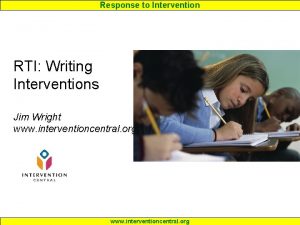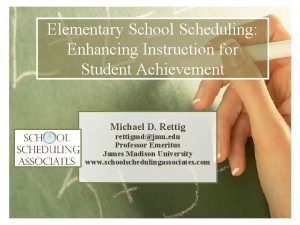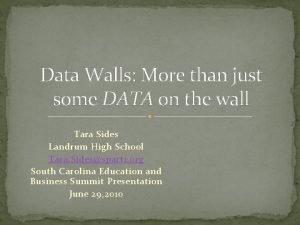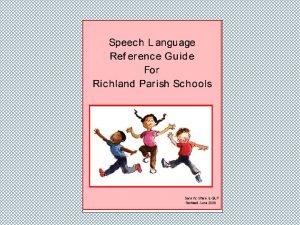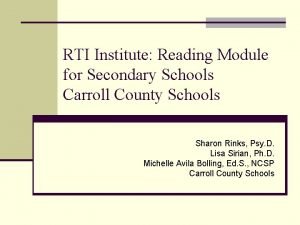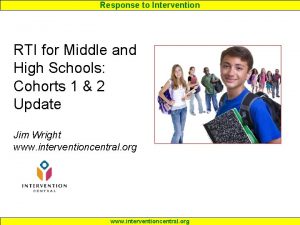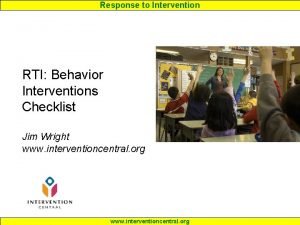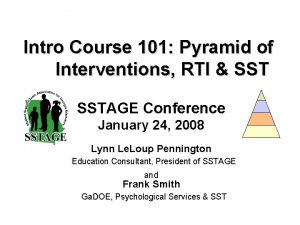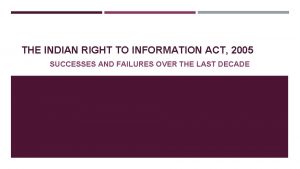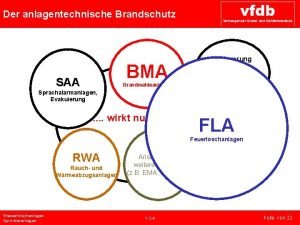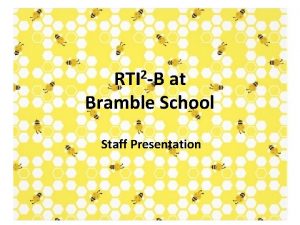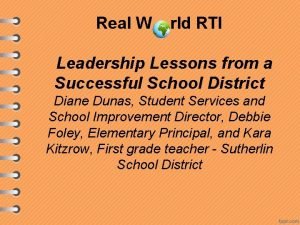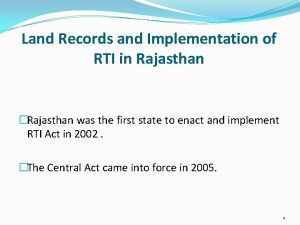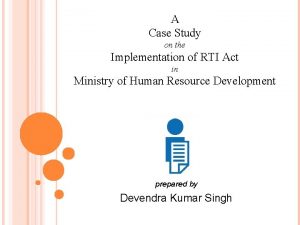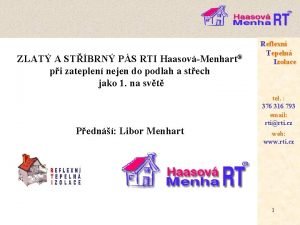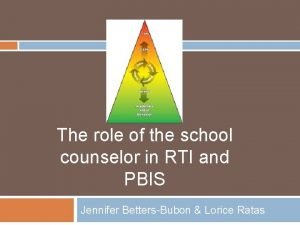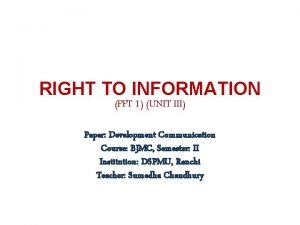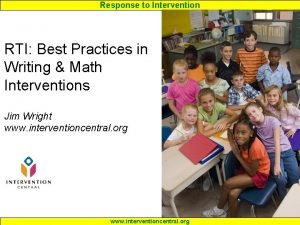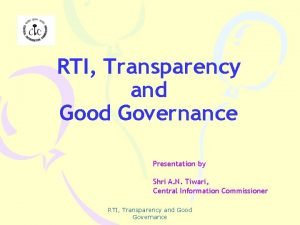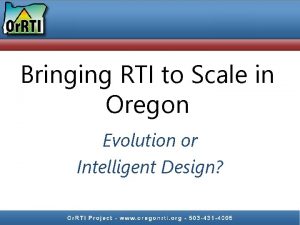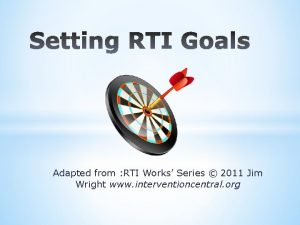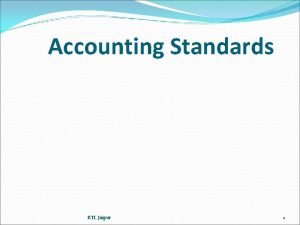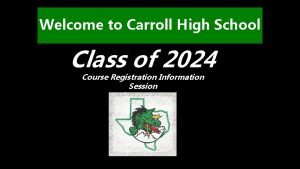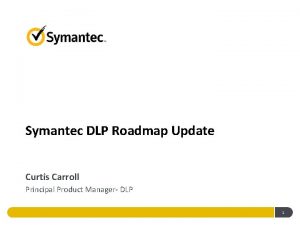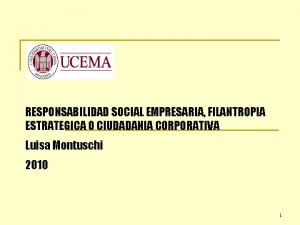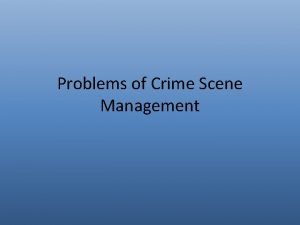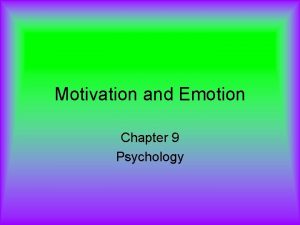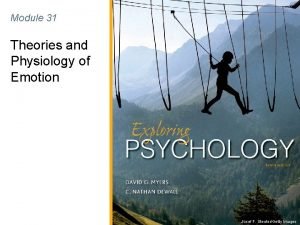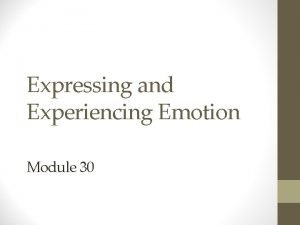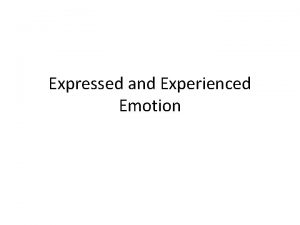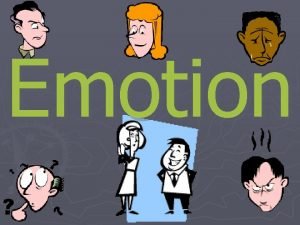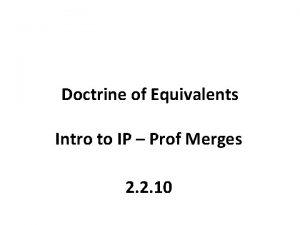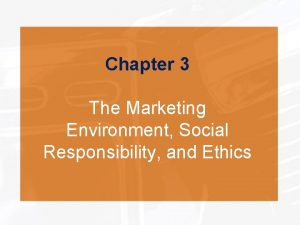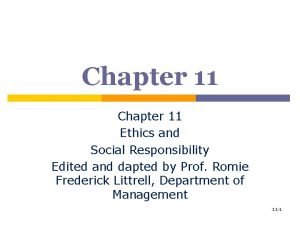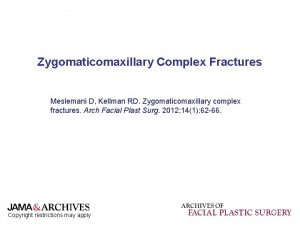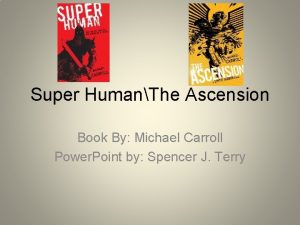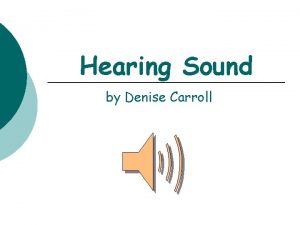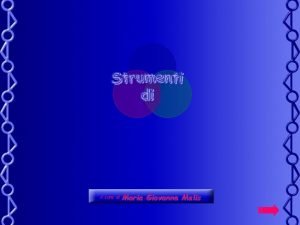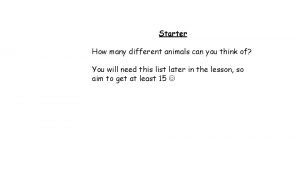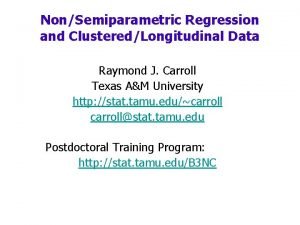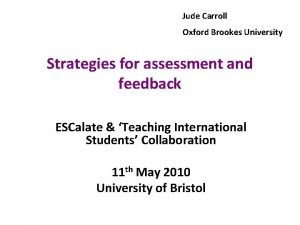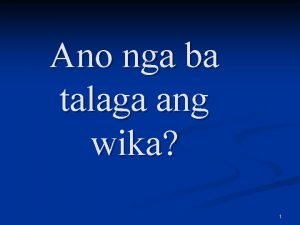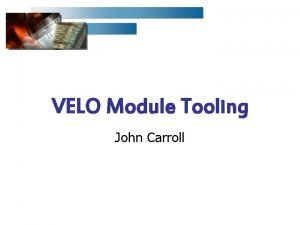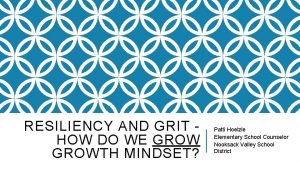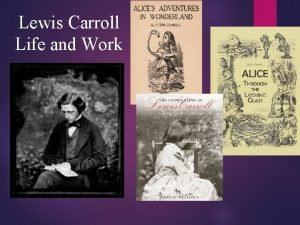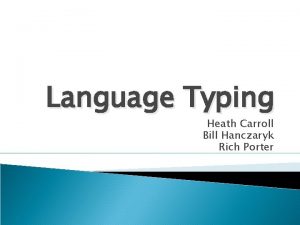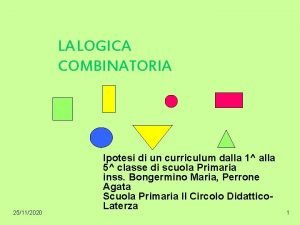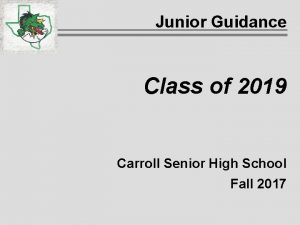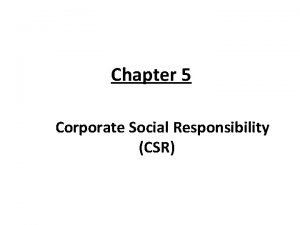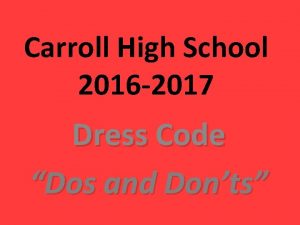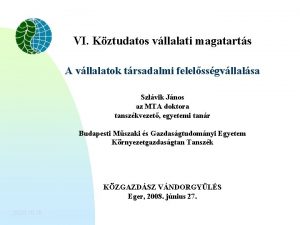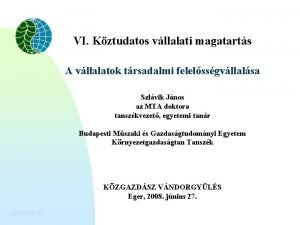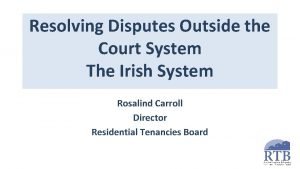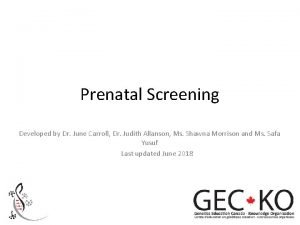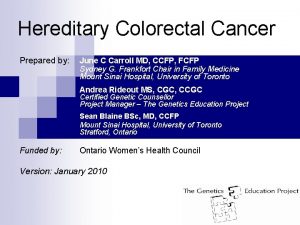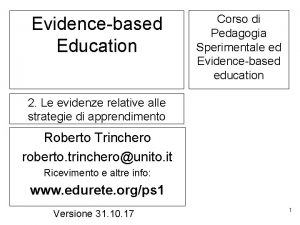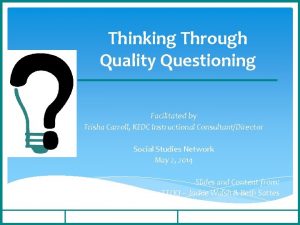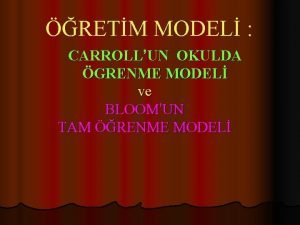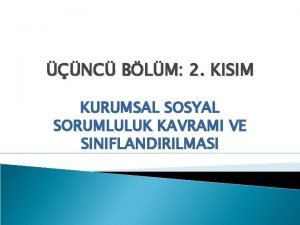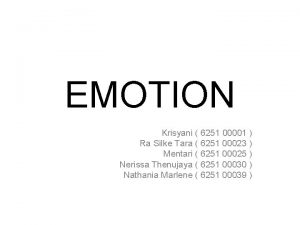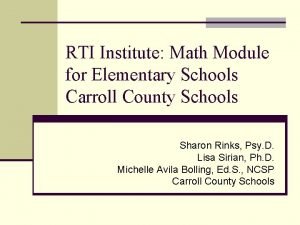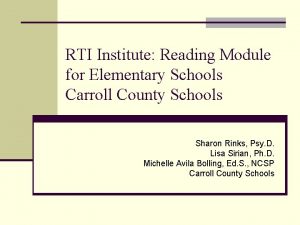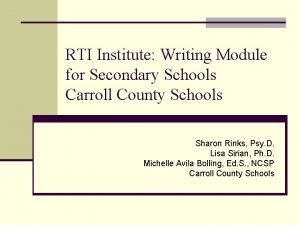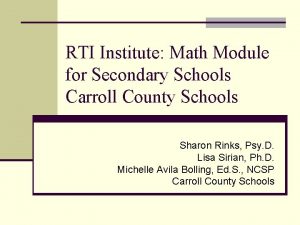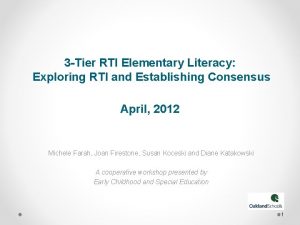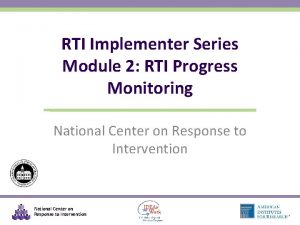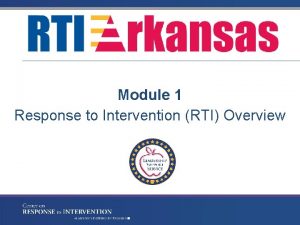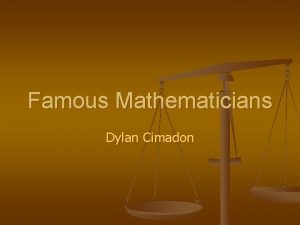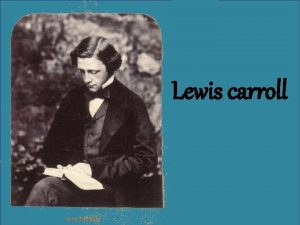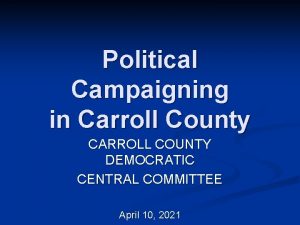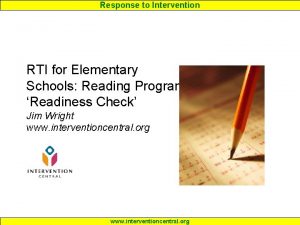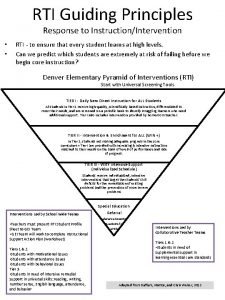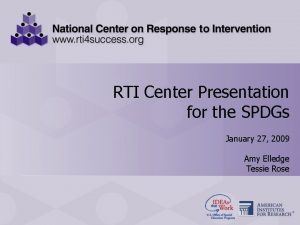RTI Institute Writing Module for Elementary Schools Carroll



























































































































- Slides: 123

RTI Institute: Writing Module for Elementary Schools Carroll County Schools Sharon Rinks, Psy. D. Lisa Sirian, Ph. D. Michelle Avila Bolling, Ed. S. , NCSP Carroll County Schools


Agenda n n n n RTI implementation status reports Process the application activity Activating prior knowledge Evidence-based RTI practices in writing n Universal screening n Intervention n Progress monitoring Practice progress monitoring scoring Case studies Discuss application activity

RTI Implementation- Status Report n Share with the group how RTI implementation is going at your school For example you might… n Talk about tools are you using n Talk about what you have planned n Talk about something creative you are doing n Discuss any roadblocks you’ve encountered n Highlight something that you are proud of n Talk about how you have used something from this training n Take notes on good ideas that you can steal… or help others problem solve.

Processing the Application Activity n Has your team begun your reading application activity? n Did you find the materials useful? n n If so, how? If not, how might they be improved? n Did you find the team able to complete the intervention form successfully? n Any questions about that? n What was the biggest challenge so far? n What kinds of changes did completing this activity spur you to make at your school?

Cut-Throat RTI Bingo! Activating Prior Knowledge

Cut-Throat RTI Bingo! n It’s every man, woman, and child for him- or herself! Hope you know your RTI vocabulary. There are two ways to win! n Make a cross n Make an X

Cut-Throat RTI Bingo! n Brief, easily administered, predictive assessments that are sensitive to small increments of change and have alternate forms available. Used at Tier 1. n When you subtract the baseline rate from the desired goal and divide by the # of weeks until the benchmark assessment, you get this. You need this to calculate the aim line.

Cut-Throat RTI Bingo! n The minimum number of times universal screening should be conducted yearly. n In graphing RTI data, this line represents the actual projected performance of the student based on the data points already gathered. If this line does not display an adequate rate of improvement, you might consider adjusting your intervention.

Cut-Throat RTI Bingo! n The ability to read a text accurately, quickly and expressively. This provides a bridge between word recognition and comprehension. n The research group who, sponsored by the federal government, reviewed over 100, 000 studies on reading instruction. This group ultimately established the essential “big five” skills for reading.

Cut-Throat RTI Bingo! n In graphing RTI data, this term refers to the line connecting the student’s baseline performance to the projected goal. n The percentage of students who should be successful with an appropriate 4 -tier service delivery model in place.

Cut-Throat RTI Bingo! n Assesses a child’s skill in reading connected text of grade-level material using one-minute probes. It is the most researched, efficient and standardized measure of reading proficiency. This can serve as a substitute for measuring overall reading proficiency, especially in the lower grades. n The ability to notice, think about, and work with the individual sounds in spoken words. This is auditory and does not involve words in print.

Cut-Throat RTI Bingo! n One of the big five in reading, this involves our knowledge of words we need to communicate effectively—these can be in speech or in print. n The practice of (1) providing high-quality instruction and interventions matched to student needs and, (2) using learning rate over time and level of performance to (3) make important educational decisions.

Cut-Throat RTI Bingo! n A type of Curriculum Based Measurement probe designed to assess comprehension and fluency of reading. This involves reading a passage from which every 7 th word has been deleted and the student must select a word from three choices provided. n The Tier 1 standards-based classroom instruction that ALL students get.

Cut-Throat RTI Bingo! n The Tier at which highly specialized services are provided to meet individual students’ needs. This is not a place, location, or specific classroom; may be provided in a regular education class or in a separate setting and may include Special Education and related services. n The percentage of students who should make benchmark with appropriate Tier 1 instruction.

Cut-Throat RTI Bingo! n The relationship between the letters (graphemes) and the sounds (phonemes) in order to read and write words. Denotes the systematic and predictable relationship between written letters and spoken sounds. n Interventions that are empirically tested using sound research methodology, accepted by experts within the field, published in scholarly research journals.

Cut-Throat RTI Bingo! n The reason for reading. The ultimate goal of reading instruction. Purposeful and active reading that occurs during passages. Involves making connections between prior knowledge and the current text. n Frequent teacher assessment of student performance using brief measures. It catches potential false positives from universal screening and is not meant to be diagnostic. It helps you figure out if your intervention is working.

Cut-Throat RTI Bingo! n The number of words at which Oral Reading Fluency typically plateaus in the middle grades. n The process of building capacity in personnel, building up resources, adding personnel, creating effective teams, and increasing skills of staff to analyze data for RTI.

Cut-Throat RTI Bingo! n Agreement from the top down and the bottom up which is essential to the RTI process. n The extent to which the intervention was implemented in the manner it was supposed to be implemented, on the number of occasions and, for the duration it was supposed to be implemented.

Activating Prior Knowledge n One of the cornerstones of an RTI model is that scientific, evidence-based Tier 1 instruction effectively eliminates inappropriate instruction as a reason for inadequate progress.

Activating Prior Knowledge n Remember that RTI is about prevention n Schools do not wait for students to fail before coming n n to their assistance Screening is conducted for all students to identify those who, despite a strong core curriculum (Tier 1), are on a path to failure To have any chance of deviating from the path to failure, students must get help early (Tiers 2 & 3) When RTI is implemented fully, reading, math, writing, and behavior screening is conducted with all students Those at risk for difficulties in one or more of these areas receive targeted evidence-based interventions (Jenkins & Johnson, 2008)

Activating Prior Knowledge n Important factors in sustainability of RTI: n extensive, ongoing professional development, n administrative support at the system and building level, n teacher buy-in and willingness to adjust their traditional instructional roles, n involvement of all school personnel, and n adequate meeting time for coordination. (Hughes & Dexter, 2008)

Exploring Evidence-Based RTI Practices for Writing

IRA and NCTE 12 ELA Standards Include the Writing Process n Students adjust their use of spoken, written, and visual language (e. g. , conventions, style, vocabulary) to communicate effectively with a variety of audiences and for different purposes n Students employ a wide range of strategies as they write and use different writing process elements appropriately to communicate with different audiences for a variety of purposes

IRA and NCTE 12 ELA Standards Include the Writing Process n Students apply knowledge of language structure, language conventions (e. g. , spelling and punctuation), media techniques, figurative language, and genre to create, critique, and discuss print and nonprint texts n Students use spoken, written, and visual language to accomplish their own purposes (e. g. , for learning, enjoyment, persuasion, and the exchange of information)

Statewide Assessment and Accountability n Writing Assessments and Benchmarks have increased demands such as: Writing in different genres n Writing for different audiences n Writing for different purposes n Demonstrating writing conventions n n n Grammar Sentence construction Spelling Writing fluently within time constraints

Research n Written Expression in the early grades is a good predictor of overall school success (Isaacson, 1985) n However, n 14% of 4 th grade students n 15% of 8 th grade students n 26% of 12 th grade students Were not able to write at even the most basic level (2002 NAEP Writing Assessment)

Writing Problems n Begin early and tend to continue with students throughout their education (Isaacson, 1995) n Often the 1 st indicator to teachers that there is a learning problem (Isaacson, 1985) n With reading problems, writing problems lead to greatest number of referrals to and placements in Special Education (Hallahan & Kaufman, 1986; Howell, Fox, & Morehead, 1993)

Components of Writing n Writing involves: n Transcription skills (low-level processes) n Self-regulation skills (high-level processes) n Most children with writing problems have difficulty with one or the other n Only 1 in 3 have difficulty with both types of processes (Juel, 1988)

Components of Writing: Writing Mechanics (Low-Level) n. Graphemic realization of writing n. Spelling n. Vocabulary n. Grammar/syntax/semantics n. Punctuation/capitalization

Components of Writing: Writing Process (High-Level) n. Acquire knowledge n. Retrieve knowledge n. Plan text n. Construct text n. Edit text n. Regulate entire process

Paradigm Shift n Shift of focus from emphasis on writing mechanics to address ways to improve writing process and content n Influenced by development of cognitive models of writing that emphasize the mental operations that skilled writers use (e. g. , planning, evaluating, revising) n Research suggests that a combination of approaches is most effective for children with writing problems

Effective Writing Instruction n Includes clear and specific objectives n Has activities for student to interact on writing tasks n Activates and builds on prior knowledge about a topic n Involves activities to organize the information n Places emphasis on text structure: narrative, expository, etc. n Teaches each step of the writing process explicitly: 1. 2. 3. 4. Establish a purpose Generate and organize ideas Put ideas in print Revise and edit (Hillocks, 1984; Isaacson, 1985)

Universal Screening in Writing n Tier 1 – all students screened for writing progress n Conducted 3 times per year n Early fall, midwinter & spring n Provides mechanism for identifying students at-risk for failure n Slightly over-identifies (false positives) n Allows schools to intervene early, before intensive intervention is necessary

Characteristics of Quality Screening Instruments n n n n Brief and easily administered Research-based Highly correlated to writing proficiency High reliability and validity Sensitive to small increments of change Alternate forms available Data analysis and reporting available

Universal Screening in Writing n AIMSweb n Uses CBM in: ORF, Maze, Early Literacy, Spelling, Early Numeracy, Written Expression, and Math n www. AIMSweb. com n Grades K-8 for universal screening n $3/student for just reading n $5/student complete (reading, language arts and math computation) n Curriculum Based Measurement - FREE

AIMSweb n There a bunch of probes and administration directions at http: //www. AIMSweb. com/measures/written/sample. php n Scores n Total Words Written (universal screening measure for grades 1 -6) n Correct Writing Sequences (universal screening measure for grades 6 -8) n Words Spelled Correctly (can be used for progress monitoring)

Benchmarks for Writing- TWW Grade Fall Winter Spring Mean ROI 1 7 14 20 . 4 2 18 23 30 . 4 3 27 34 39 . 3 4 37 42 47 . 3 5 42 46 50 . 2 6 45 49 55 . 3 7 47 52 57 . 3 8 50 56 61 . 3 IMPORTANT NOTE: THESE NORMS ARE ALL FOR 3 MINUTES OF WRITING -- From AIMSweb, 2007

Benchmarks for Writing- CWS Grade Fall Winter Spring Mean ROI 1 3 6 11 . 2 2 9 16 21 . 4 3 19 26 30 . 3 4 28 34 40 . 4 5 35 40 46 . 3 6 41 46 50 . 3 7 45 50 53 . 2 8 50 52 56 . 2 IMPORTANT NOTE: THESE NORMS ARE ALL FOR 3 MINUTES OF WRITING -- From AIMSweb, 2007

Curriculum Based Measurement (CBM) n Alternate forms of equal difficulty n Sample of the year-long curriculum n Highly standardized n Given at regular intervals n Brief and easy to administer n Assess the same skill at the same difficulty level

Curriculum Based Measurement (CBM) n Written Expression can be used as a universal screener in grades 1 -12 n As soon as the child can write a sentence n Spelling CBM can be used in grades 1 -6 n More useful as a progress monitoring tool than a universal screener n Loses reliability toward the upper grades n Directions and probes are included on the CD

Research on CBM n When teachers use CBM to guide instructional decision making: students learn more, n teacher decision-making improves, n and students are more aware of their own performance. n (e. g. , Fuchs, Deno, & Mirkin, 1984)

Research on CBM n Reliability: a test consistently measures in the same way Inter-rater reliability n Test-retest, etc. n n Validity: a test measures what it is intended to measure n Using the SAT-9 as the criterion, CBM Writing was found to be reliable and valid (Gansle, Van. Derheyden, Noell, Resetar, & Williams, 2006)

Research on CBM n For secondary students: n Total Words Written (TWW) and Total Words Spelled Correctly (TWS) are LESS reliable and valid than other indices in higher grades n Correct minus Incorrect Word Sequences (CIWS) seems to have the most reliability More sensitive to change (important for progress monitoring) n Independent of the prompt n (Mc. Master & Espin, 2007)

Interventions n Six Areas n Beginning Writing n Handwriting n Spelling n Editing n Planning n Fluency n Comprehensive Strategies

Beginning Writers n Young writers with and without learning disabilities spend little time planning before they write; they plan as they write without thinking ahead of time about content or organization schemes (Burtis, Bereiter, Scardamalia, and Tetroe, 1983; Graham, Harris, Mac. Arthur, and Schwartz, 1991) n Important note: Many beginning writers struggle with phonics. It is appropriate for these students to use the Phonics intervention strategies from the reading CD.

Strategies for Beginning Writers n Draw a Story n Making Words n Graham’s Alphabet Exercises n Share the Pen n Writer’s Workshop n Word Sorts for Beginning and Struggling Readers

Draw A Story (Renee Goularte, readwritethink. org) n Introduces students in grades K through 2 to the writing process in a way that supports the transition from oral to written storytelling n Useful in helping students work with sequential content that includes character, action, problem, and solution

Draw A Story (Renee Goularte, readwritethink. org) n Students draw a series of pictures that tells a simple, sequential story n They ‘read’ their story to others, transcribe their oral story into writing, and create an accordion book with drawings on the front side and writing on the back

Writer’s Workshop n Mini-lessons/Class Status n The Writing Process/Conferencing n Rehearsal, drafting, editing, & revising n Sharing/Author’s Chair/Publication n Jasmine & Weiner, 2007 n Increased enthusiasm n Increased confidence n Increased proficiency

Taking the Orthographic Process Out of the Equation n Students with LD who dictated their stories had more written output (De La Paz & Graham, 1995) n In some studies the amount tripled for LD students who dictated (Mac. Arthur & Graham, 1987)

Handwriting Strategies n Handwriting Without Tears n Making and Writing Words n Graham’s Alphabet Exercises n Word Ladders

“Graham’s Alphabet Exercises” (Graham, Harris, & Fink, 2000) q q q To teach the lowercase manuscript alphabet Designed to be implemented individually by a tutor Three new letters are introduced in each instructional unit (e. g. , l, i, t) Each unit has three lessons Easier and more frequently used letters taught first Each lesson includes four activities: n n Alphabet Warm-Up Alphabet Practice – to teach how to write specific letters Alphabet Rockets – to increase handwriting speed Alphabet Fun – to ensure lessons end enjoyably

Word Ladders n Children are given a key phrase n Letters in the key phrase are used to compose new words based on teacher prompts and hints n Fun supplemental intervention that can be added to your curriculum to get students involved in manipulating sounds in words to increase spelling and orthographic skills n For handwriting, emphasis should be placed on the skill of copying of the word

Word Ladders Key Phrase: Team to Work Target Word Letter Changes Required Clue Team Meat Rearrange letters Food that comes from animals. Tame Rearrange letters Not wild. Take Chg 1 To get possession of something. To grab. Tale Chg 1 A story. Tall Chg 1 Not short. Toll Chg 1 A fee paid for a service or privilege. We had to pay a one dollar toll to cross the bridge. Ton -2, + 1 A weight, 2, 000 pounds. Torn +1 To have divided or separated something by pulling. Worn Chg 1 To have caused something to deteriorate or go bad by using it or wearing it out. Work Chg 1 What teams must do together.

Research on the Writing Process n Spelling accounts for 41% of variability in writing (Graham, Berninger, & Abbot, 1997) n Handwriting fluency accounts for 66% of variability in writing (Graham, Berninger, & Abbot, 1997) n Extra handwriting instruction and practice increase writing output of poor writers (Berninger, et al. , 1997)

Spelling Strategies n Cover, Copy, Compare n Making Words n Making and Writing Words n Word Ladders

Making Words (Cunningham and Cunningham, 1992) Making & Writing Words (Rasinski, 1999) n Early writers can begin the writing process by learning to spell simple words with letter cards, tiles, or plastic letters (Making Words) n Using representations of the letters removes the cognitive demand of the orthographic process and isolates the phonetic process involved in spelling n More advanced writers do the same activities with pencil and paper (Making & Writing Words)

Making Words (Cunningham and Cunningham, 1992) Making & Writing Words (Rasinski, 1999) The Challenge Word: SPORT n Words list in order: to, so, or, pot, rot, top, sop, port, stop, pots, SPORT n The teacher would say: 1. 2. 3. 4. 5. n With two letters, make the word “to”. I like to spell words. Change one letter and turn “to” into “so”. So I will be a good speller when I grow up. Let’s make a three letter word now. With three letters, make “pot”. I cook soup in a pot. Etc… There is a word we can make using ALL of these letters. Has anyone figured it out? A hint may be provided: “basketball, baseball, soccer, and volleyball are all examples of this word. ” If they don’t get it… you can provide the word. For the sorting activity the teacher might say: 1. 2. 3. Words that have the /or/ sound… or, port, sport. Words that are verbs/action words… rot, sop, sort, stop. Etc…

Cover, Copy, Compare (Skinner, Mc. Loughlin & Logan, 1997) n Flexible implementation – individual, small groups, or whole n n n group Can be facilitated by an adult or, once mastered by the student, it can be used as a self-management strategy The student examines (and visualizes) the words Student COVERs the prompt, then writes the word from memory (COPY) Then the student COMPAREs his or her product to the stimulus The student does not erase their first response The student repeats the CCC strategy until they have the correct response before moving to the next stimulus

Cover, Copy, Compare (Skinner, Mc. Loughlin & Logan, 1997) n Enhancing Cover, Copy, Compare: n Set a time limit n Use conspicuous timing n Incorporate goal setting n Provide feedback n Vary the response format (vocal, written, etc. ) n If done whole group, group contingencies can be used to increase motivation and on-task behavior

Editing Strategies n COPS/ SH! COPS n SCAN n SCOPE

The SCAN Strategy (Graham & Harris, 1999) n Mnemonic strategy that cues students through an editing process to edit written work n Particularly useful for persuasive writing n Focuses on: n n n clarity cohesiveness correctness n Initially developed for use with word processed writing, but it can be implemented with hard copies as well

The SCAN Strategy (Graham & Harris, 1999) n SCAN Steps n Reread your essay n Find the sentence that tells what you believe – is it clear? n Add two more reasons why you can believe it n SCAN each sentence. n Does it make sense? n Is it connected to my belief? n Can I add more? n Note errors n Make your changes

Graham & Harris, 1994, 1997 n Children with LD in writing have difficulty: n Planning n Monitoring n Evaluating n Revising n Generating ideas

Planning Strategies n Giraffe n WWW. What=2, How=2 n TREE n DARE n SPACE

Teacher-Directed Strategy Instruction n Specifically studying the DARE and SPACE strategies: Students with this direct instruction made significant gains in overall story quality and wrote substantially longer stories n Students in the strategy instruction group used more planning and spent more time in prewriting for story writing n (Troia & Graham, 2002)

WWW. What=2, How=2 (Graham, Harris, & Sawyer, 1987) n Narrative text (story) writing strategy that cues students through a planning process to compose stories that are organized and wellwritten n Cues the students with a series of questions to ensure that all story components are included

WWW. What=2, How=2 (Graham, Harris & Sawyer, 1987) 1. Activate prior knowledge 2. Discuss the strategy 3. Model the strategy using a think aloud and self- reinforcement (positive self-talk) 4. The children then memorize the strategy 5. Support the strategy 6. Fade prompts; encourage generalization From Strategy Instruction for Students with Learning Disabilities (Reid & Lienemann, 2006)

WWW. What=2, How=2 (Graham, Harris & Sawyer, 1987) n Think of a story to share. n Let your mind be free. n Write down the story part reminder: n n n n Who is the main character? Who else is in the story? When does the story take place? Where does the story take place? What does the main character do? What happens when they try to do it? How does the story end? How does the main character feel? n Write down story part ideas for each part. n Write your story. Use good parts and make sense.

Fluency Strategies n Self Monitoring n Repeated Writing n Writing Every Day n Share the Pen

Share the Pen (Pinnell & Mc. Carrier, 1994) n Interactive writing strategy n Students choose an activity they’ve shared and “share the pen” in recording the story n As each new word or sentence is added, the story is read again n Teacher facilitates discussion about the experience from beginning to end

Share the Pen (Pinnell & Mc. Carrier, 1994) n Teacher starts by asking the group to come up n n with a topic Teacher then selects/asks for volunteers to begin the story Each student verbalizes a sentence, writes it down, and reads it aloud The pen is handed to the next volunteer and the process continues The final product is read aloud by various students

Typing/Word Processing n Typing is often felt to be a way to free up cognitive n n resources during the writing process for those with orthographic-motor integration issues BUT, typing only helps if the child has automaticity with typing– otherwise no cognitive resources are freed up When a child learns to type with ease, then you may see increased written output with this intervention Also, use of word processing makes the revision process easier and less painful for students Typing skill impacts quantity, but has little effect on quality of writing (Christensen, 2004)

Typing Programs for Kids http: //typing-for-kids-software-review. toptenreviews. com/

Comprehensive Strategies n POWER n DEFENDS n Writer’s Workshop n Step Up to Writing n 6 Trait Writing

POWER (Englert, Raphael, & Anderson, 1991) n POWER: Plan, Organize, Write, Edit, and Revise n Comprehensive procedure to explicitly teach the stages of the writing process n Based on cognitive strategy instruction n Four phases: text analysis, modeling the writing process, guided student practice in composition, and independent writing n Uses “Think Sheets” and “Pattern Guides”

POWER (Englert, Raphael, & Anderson, 1991)

Step Up to Writing n Explicit instruction in organizing writing n Small group planning n Multisensory techniques Color coding to visualize writing organization by equating the colors of a traffic signal with different parts of a written piece n Using colors and folding paper, students structure and place main ideas and supporting information to achieve cohesive, organized paragraphs Guided exercises and practice Work collaboratively in small groups Sharing Feedback n n n

Step Up to Writing

Team Work: Case Study Create an Intervention Plan Look at the individual student data in the case study. Use your CD and team knowledge to complete a Tier 2 intervention plan for the student.

Progress Monitoring Writing

Gender Differences n Girls typically outperform boys on CBM writing fluency measures girls write more under time constraints n Gender differences iron out in the areas of quality or accuracy what girls write is not necessarily qualitatively better than what boys write n This is important when we start talking about the ways that we progress monitor children (Jewell & Malecki, 2005)

Progress Monitoring n More frequent progress monitoring has been found to increase accuracy (Skinner, Mc. Loughlin & Logan, 1997) n Most of the procedures described here are from the manual Using CBM for Progress Monitoring in Written Expression and Spelling by L. Fuchs & D. Fuchs, 2007 n The entire manual has been included (with permission by the authors) on your CD in the Progress Monitoring folder n Additional information and resources can be downloaded at www. studentprogress. org

Spelling CBM n Group or individual administration n Students write spelling words that are orally presented by the teacher n n n Teacher presents a word and uses it in a sentence Students are given 10 seconds to write the word Then the next word is presented There is a 2 minute time limit Teacher presentation time is not counted in the 2 minute administration time n Spelling CBM probes are scored after the administration is complete (Fuchs & Fuchs, 2007)

Spelling CBM n Random lists of words need to be generated n Word lists can come from any source n Words should come from same source and sample grade-level words taught in students’ spelling program n Lists of words are generated from the master list for each Spelling CBM administration (Fuchs & Fuchs, 2007)

How to Score Spelling CBM n Scoring a Spelling CBM: Correct letter sequences (LS) Each pair of letters that appear together correctly is marked with a carat -- ^ n If the 1 st letter is correct, a carat is placed before that letter n If the last letter is correct, a carat is placed after that letter n So the max score for each word = # of letters +1 n (Fuchs & Fuchs, 2007)

How to Score Spelling CBM n Let’s look at the word “write”

Let’s Practice Score the spelling probe. What is the number of correct letter sequences?

Spelling CBM Practice

LS = 80 out of 97 Spelling CBM Practice (82% correct)

How to Identify the Level of Material for Monitoring Progress n For Spelling: n If a student earns less than half of the total possible letter sequences, a Spelling CBM probe from the next lower grade should be administered n Once the appropriate Spelling CBM grade level is determined, students should use the same grade-level word lists for the entire year

Writing CBM Norms (Fuchs & Fuchs, 2007)

How to Administer Written Expression CBM n Narrative writing story starters: n Familiar theme should be used n Starters should always end in mid-sentence n Starter is written at top of student CBM probe (Fuchs & Fuchs, 2007)


Another Example n One day I went to school but nobody was there except me … ____________________________________ ____________________________________

A Pretty Example This prompt is reproduced here with permission of the author. More (about 30 or so) can be found in the Writers Workshop area at http: //www. meddy bemps. com/ You can order a CD there with 101 of them for $15. 95. Four examples can be found on the CD from this session.

Here’s another http: //www. meddybemps. com/

How to Administer Written Expression CBM n Administered to entire class at one time n Students presented with a story starter read aloud by the n n teacher Students are given time to formulate their writing (30 seconds) Story starter is re-read Students write for a set amount of time (to remain consistent throughout the year) Teacher scores Written Expression CBM probes after administration is complete (Fuchs & Fuchs, 2007)

Suggested Time Limits for CBM Writing Probes Grade Level Time Mid-elementary 3 minutes Late-elementary 5 minutes Middle school 7 minutes High school 7 minutes (Fuchs & Fuchs, 2007)

How to Score Written Expression CBM n Several ways to score Written Expression CBM n Total words written (TWW) n Total words spelled correctly (TWS) n Correct word sequences (CWS) n Correct minus incorrect word sequences (CIWS) n Teachers can use a combination of scoring methods n Should remain consistent throughout the entire school year (Fuchs & Fuchs, 2007)

Writing Fluency n The total number of words (TWW) a student writes in a timed response is a reliable and valid measure of writing proficiency (Marston, 1989; Shinn, 1989) n TWW is a good universal screener at the lower levels n It loses reliability in the upper grades

Production Dependent vs. Production Independent Measures n Production Dependent – focuses on how much text is generated n Production Independent – focuses on the quality of text generated regardless of the amount generated n n Students in the upper grades should use measures that are production independent Assessment of beginning writers should focus first on quantity (production dependent TWW, WSC & CWS) then move toward more production independent measures (Jewell & Malecki, 2005)

How to Score Written Expression CBM n Total Words Written (TWW): n Count the total number of words written n Spelling, word usage, capitalization, and punctuation are ignored (Fuchs & Fuchs, 2007)

Example

How to Score Written Expression CBM n Total Words Spelled correctly (TWS): n Count the total number of words spelled correctly n Any correctly spelled English word is counted as correct n Word usage, capitalization, and punctuation are ignored (Fuchs & Fuchs, 2007)

Example TWS = 23

How to Score Written Expression CBM n Correct Word Sequences (CWS): n Quantifies writing, but also accounts for qualitative differences n Takes into account punctuation, capitalization, word usage, etc. n Count the number of correct word sequences (Fuchs & Fuchs, 2007)

How to Score Written Expression CBM n Correct Word Sequences (CWS): n CWS is any two adjacent, correctly spelled words acceptable within the context of the sample to a native English speaker n The two words must be syntactically and semantically correct (Fuchs & Fuchs, 2007)

How to Score Written Expression CBM n Correct Word Sequences (CWS): n Vertical line placed where a sentence should end n n Judgment plays a role: make a decision rule and stick to it Incorrect words are underlined n Incorrect words are: words spelled incorrectly, grammatically incorrect words, and words used incorrectly (Fuchs & Fuchs, 2007)

Example

How to Score Written Expression CBM n Correct Word Sequences (CWS): n Carats are placed below two words that represent an incorrect word sequence: Any two underlined words n An underlined word and a non-underlined word n Between an underlined or mis-capitalized word and line at beginning of a sentence n Between an underlined word and punctuation at end of a sentence n (Fuchs & Fuchs, 2007)

Example

How to Score Written Expression CBM n Correct Word Sequences (CWS): n Carats are placed above two words that represent a CWS Any two non-underlined words n Between a non-underlined word and the line at the beginning of a sentence n Between a non-underlined word and the correct punctuation at the end of a sentence n (Fuchs & Fuchs, 2007)

Example

Let’s Practice! On your own. Score the writing prompt “One day I went to school, but…”

Check Your Scoring V TWW = 97 CWS = 84 TWS = 91 CIWS = 62

Using Rubrics to Describe Strengths and Weaknesses n The Fuchs & Fuchs manual on the CD provides information on how to use a rubric to qualitatively evaluate written expression probes n The procedure adapted is from: Tindal, G. , & Hasbrouck, J. , 1991, Analyzing student writing to develop instructional strategies. Learning Disabilities Research and Practice, 6, 237– 245.

Rubric for Handwriting

Rubric for Paragraph Writing

Team Work: Case Study Evaluate an Intervention Plan Look at the individual student data in the case study. Use data-based decision making to evaluate the student’s response to Tier 3 intervention.

Sarah’s Response to Intervention

Application Activity n Select a student with a writing concern n Collect baseline data using an appropriate progress n n n n monitoring tool Establish a goal Enter the data into the Excel graphing tool Determine the intervention strategy and the schedule of implementation Determine who will do it Establish a method and schedule for progress monitoring Document on the appropriate Tier Intervention Form Begin the intervention
 Lewis carroll elementary school calendar
Lewis carroll elementary school calendar Writing interventions
Writing interventions Huntsville powerschool
Huntsville powerschool Safety target and reach schools
Safety target and reach schools Parallel block scheduling for elementary schools
Parallel block scheduling for elementary schools Data walls for teachers
Data walls for teachers Https://serp.doe.louisiana.gov
Https://serp.doe.louisiana.gov Rti graph
Rti graph Rti scheduler
Rti scheduler Jim wright rti
Jim wright rti Rti interventions examples
Rti interventions examples Rti act 2005 introduction
Rti act 2005 introduction Hmrc rti gtax
Hmrc rti gtax Sprinkler sprühbild
Sprinkler sprühbild Rti templates
Rti templates Rti 2
Rti 2 Rti meaning real estate
Rti meaning real estate Heraus ragen
Heraus ragen Rti portal rajasthan
Rti portal rajasthan Rti zeromq
Rti zeromq Pegasus opera 3 review
Pegasus opera 3 review Suo-moto meaning
Suo-moto meaning Rti izolace
Rti izolace Rti school counseling
Rti school counseling Rti act ppt
Rti act ppt Rti interventions list
Rti interventions list Transparency of good governance
Transparency of good governance Upper rti
Upper rti Rti oregon
Rti oregon Jim wright rti
Jim wright rti Rti jaipur
Rti jaipur C device module module 1
C device module module 1 Naviance carroll isd
Naviance carroll isd Dlp roadmap
Dlp roadmap La piramide de carroll
La piramide de carroll Exigent circumstances
Exigent circumstances Carroll izard 10 basic emotions
Carroll izard 10 basic emotions 10 primary emotions carroll izard
10 primary emotions carroll izard Archie carroll pyramid of csr
Archie carroll pyramid of csr Ariel carroll
Ariel carroll Module 30
Module 30 What is this emotion
What is this emotion 10 primary emotions carroll izard
10 primary emotions carroll izard Carroll doctrine
Carroll doctrine Archie carroll pyramid of csr
Archie carroll pyramid of csr Archie carroll pyramid
Archie carroll pyramid Kristopher carroll charlotte nc
Kristopher carroll charlotte nc Carroll girard screw
Carroll girard screw The ascension michael carroll
The ascension michael carroll Lewis carroll alisa u zemlji čudesa
Lewis carroll alisa u zemlji čudesa Enti derivati geometria
Enti derivati geometria Denise carroll
Denise carroll Clara elisa melis
Clara elisa melis Carroll diagram animals
Carroll diagram animals Raymond carroll tamu
Raymond carroll tamu Jude carroll
Jude carroll Ano ang wika para kay edward sapir
Ano ang wika para kay edward sapir John carroll
John carroll Lewis carroll wonderful
Lewis carroll wonderful Pete carroll
Pete carroll Lewis carroll
Lewis carroll Lorena little lewis carroll
Lorena little lewis carroll Lewis carroll
Lewis carroll Heath carroll
Heath carroll Classificare in base ad un attributo
Classificare in base ad un attributo Carroll senior high school counselors
Carroll senior high school counselors Social obstruction in ethics
Social obstruction in ethics Carroll high school dress code
Carroll high school dress code Carroll
Carroll Maslow piramis
Maslow piramis Csr piramis
Csr piramis Carroll
Carroll Rosalind carroll
Rosalind carroll Confined placental mosaicism
Confined placental mosaicism Lewis carroll ppt
Lewis carroll ppt Lewis carroll photography
Lewis carroll photography Carroll
Carroll Diagramma di flusso scuola primaria
Diagramma di flusso scuola primaria Etyka gospodarcza i zawodowa
Etyka gospodarcza i zawodowa Trisha carroll
Trisha carroll Okulda öğrenme modeli
Okulda öğrenme modeli Jabberwocky onomatopoeia
Jabberwocky onomatopoeia Archie carroll
Archie carroll Cs lewis dot
Cs lewis dot 2 fast 2 furious tara carroll
2 fast 2 furious tara carroll Kontinuitetshantering
Kontinuitetshantering Typiska novell drag
Typiska novell drag Tack för att ni lyssnade bild
Tack för att ni lyssnade bild Ekologiskt fotavtryck
Ekologiskt fotavtryck Shingelfrisyren
Shingelfrisyren En lathund för arbete med kontinuitetshantering
En lathund för arbete med kontinuitetshantering Särskild löneskatt för pensionskostnader
Särskild löneskatt för pensionskostnader Personlig tidbok för yrkesförare
Personlig tidbok för yrkesförare Anatomi organ reproduksi
Anatomi organ reproduksi Vad är densitet
Vad är densitet Datorkunskap för nybörjare
Datorkunskap för nybörjare Boverket ka
Boverket ka Mall debattartikel
Mall debattartikel Delegerande ledarstil
Delegerande ledarstil Nyckelkompetenser för livslångt lärande
Nyckelkompetenser för livslångt lärande Påbyggnader för flakfordon
Påbyggnader för flakfordon Formel för lufttryck
Formel för lufttryck Publik sektor
Publik sektor Kyssande vind
Kyssande vind Presentera för publik crossboss
Presentera för publik crossboss Argument för teckenspråk som minoritetsspråk
Argument för teckenspråk som minoritetsspråk Kanaans land
Kanaans land Klassificeringsstruktur för kommunala verksamheter
Klassificeringsstruktur för kommunala verksamheter Mjälthilus
Mjälthilus Claes martinsson
Claes martinsson Cks
Cks Lågenergihus nyproduktion
Lågenergihus nyproduktion Mat för unga idrottare
Mat för unga idrottare Verktyg för automatisering av utbetalningar
Verktyg för automatisering av utbetalningar Rutin för avvikelsehantering
Rutin för avvikelsehantering Smärtskolan kunskap för livet
Smärtskolan kunskap för livet Ministerstyre för och nackdelar
Ministerstyre för och nackdelar Tack för att ni har lyssnat
Tack för att ni har lyssnat Referatmarkeringar
Referatmarkeringar Redogör för vad psykologi är
Redogör för vad psykologi är Matematisk modellering eksempel
Matematisk modellering eksempel Tack för att ni har lyssnat
Tack för att ni har lyssnat Borra hål för knoppar
Borra hål för knoppar Orubbliga rättigheter
Orubbliga rättigheter

